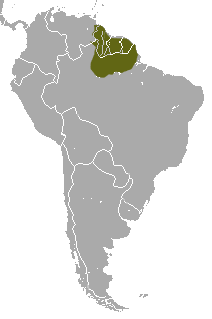Red-faced spider monkey
| Red-faced spider monkey[1] | |
|---|---|

| |
| Red-faced Spider Monkey in La Vallée des Singes, France. | |
| Scientific classification | |
| Kingdom: | |
| Phylum: | |
| Class: | |
| Order: | |
| Family: | |
| Genus: | |
| Species: | A. paniscus
|
| Binomial name | |
| Ateles paniscus | |

| |
| Red-faced spider monkey range | |
The red-faced spider monkey (Ateles paniscus) also known as the Guiana spider monkey or red-faced black spider monkey, is a species of spider monkey found in the rain forests in northern South America.
The species faces issues with hunting and habitat loss, so is listed as Vulnerable on the IUCN Redlist.
Description

The red-faced spider monkey has long, black hair and a red or pink face that is bare except for a few short, white hairs.[4] Infants are born with dark faces, which lighten as they age.[4] Sexual dimorphism in the species is small; the head-body length of the male is 55.7 centimetres (21.9 in) on average, while the female is around 55.2 cm (21.7 in) in length.[4] The male weighs around 9.1 kg (20 lb), while the female weighs around 8.4 kg (19 lb).[2] The tail is prehensile (capable of grasping) and its fingers and limbs are long, agile and strong.
Behavior
The red-faced spider monkey exhibits a fission-fusion society, associating with large groups of up to 30 individuals during the night, but choosing to spend the days travelling, foraging, and resting in much smaller groups.[4][2] At dusk, they recongregate using a greeting call to communicate. At night, they often sleep in large groups called bands. Bands typically consist of several females, with their respective young, along with a few males for protection. The only range size estimate was 255 hectares (630 acres), of which 220 ha (540 acres) had suitable habitat.[2]
The red-faced spider monkey feeds on a variety of foods and would be considered an omnivore. It will eat termites and grubs, but also feeds on supple leaves, flowers, berries and fruit.
It has a gestation period of 226–232 days, is weaned after four or five years when it reaches sexual maturity, and has a life span of up to 33 years in captivity.[4][2]
Habitat and distribution
The red-faced spider monkey is a habitat specialist, found in undisturbed primary rainforests,[4] in northern Brazil, Suriname, Guyana, and French Guiana.[2] Because of its ability to climb and jump, the red-faced spider monkey tends to live in the upper layers of the rainforest trees and forages in the high canopy.[4]
Conservation
The red-faced spider monkey occurs in many protected area across its range,[2] and is protected in the Amazon under the Amazon Animal Protection Act of 1973. It is listed by the IUCN Red List as Vulnerable.[2]
Further reading
- Neotropical Rainforest Mammals (1997), Louise Emmons and Francois Feer
- MacDonald, David W. (2006). Encyclopedia of Mammals, Volume 2. Facts on File. p. 333.
- Burnie, David and Wilson, Don (2001). Animals. DK Publishing, Inc. p.123.
- Stewart, Melissa (2008). New World Monkeys. Lerner Publications Company. p.27-29
- Redmond, Ian (2008). The Primate Family Tree. Firefly Books Ltd. p.97
References
- ^ Groves, C. P. (2005). Wilson, D. E.; Reeder, D. M. (eds.). Mammal Species of the World: A Taxonomic and Geographic Reference (3rd ed.). Baltimore: Johns Hopkins University Press. p. 151. ISBN 0-801-88221-4. OCLC 62265494.
- ^ a b c d e f g h Template:IUCN2011.2
- ^ Linnaeus, Carl (1758). Systema naturæ. Regnum animale (10 ed.). p. 26. Retrieved 19 November 2012.
- ^ a b c d e f g Cawthon Lang, K. A. (10 April 2007). "Black spider monkey (Ateles paniscus)".

